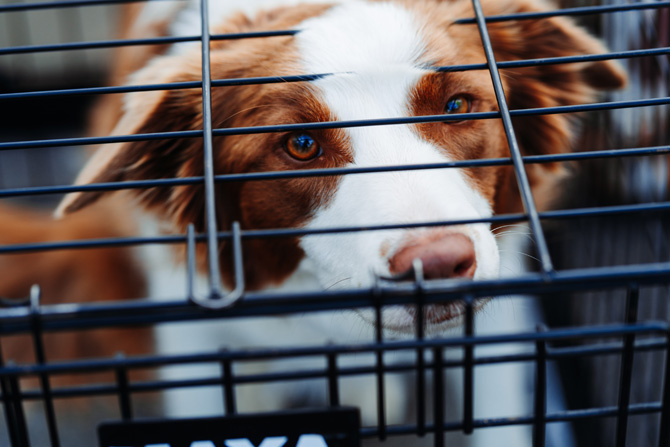You may think crate training your dog is kind of cruel but, in actual fact, it’s effective and helps a dog to feel secure.
According to the RSPCA, if crate training is performed correctly it can bring many benefits. However, it points out that this form of training might not suit all dogs, nor should it replace exercise and play.
So, if you are considering crate training your beloved fur pal, keep on reading to find out how to do it properly.
What are the benefits of crate training?
Certainly, crate training is not the only training method that can be used for dogs. However, there are many known benefits to crate training. Here are a few of them.
Crate training can help stop puppies and older dogs from ‘doing their business’ where they shouldn’t. Indeed, because the crate becomes the dog’s sleeping area, our furry friends learn to hold their bladder.
Crates help our barking buddies to self soothe. It provides a place of comfort and calm. So, whenever your pooch feels anxious or overwhelmed he or she has a safe space (AKA the crate!).
Crate training your dog from an early age will make travel a lot easier. Whether you’re travelling bar car or air, your dog will be used to the environment of the crate and is less likely to be uncooperative.
How to crate train your dog
So, assuming you’re comfortable with the idea of crate training your dog, it’s a good idea to clue up on how to go about this type of training before you begin. After all, it’s important your dog feels comfortable and secure at all times — otherwise, the crate will become his archenemy!
Firstly, it’s essential to select the right type of crate. It should be large enough for your dog to stand up and turn around in. Crates come in various materials, including metal, plastic and fabric, so consider which material is best for you and your pooch.
Next up, you must introduce your fur pal to its crate using positive reinforcement. It might be a good idea to lay a nice blanket on the floor of the crate or place your dog’s bed inside. Lay some treats down or your dog’s favourite toy to encourage your dog to explore the crate.
TIP: If your dog refuses to go in the crate just reward your dog for going near the crate. Once your dog finally enters the crate give him praise.
To make certain your furry friend has a positive view of his crate DO NOT close the door on him. Not yet, anyway! You want your dog to think of the crate as his ‘safe place’, not a prison. Allow him to come in and out as he pleases and keep giving him treats for doing so.
Following on from this begin giving your dog his meals in the crate. Again, this is so that he associated the crate with food and happiness.
The next step is to close the door. Start closing the door while your dog eats his dinner. However, be sure to open it once he’s finished. Start to lengthen out the amount of time your dog is in the crate with the door closed. Just make sure he looks comfortable.
It’s important to vary the amount of time the dog remains in the crate. This is to stop your four-legged friend from expecting to be let out at a certain time.
TIP: If your dog whines or scratches at the door ignore it, but let him out and give praise as soon as he’s quiet. Another thing to remember is that some dogs will take to crate training quickly and easily, while others may take longer. It’s important to take it slow.
Over time, you can start to confine your dog to the crate for longer periods and, eventually, overnight. Keep in mind your dog should consider its crate a pleasant place to be, not punishment.
4 common crate training mistakes
Crate training might sound pretty straightforward, but inevitably there are common mistakes people tend to make. Here are a few to avoid.
1. Moving too quickly
The key to crate training is to take things slow and steady. Many owners rush things, which can create fear and anxiety in dogs. It’s important to allow dogs time to explore the crate in their own time and don’t forget the rewards!
2. Too long spent in the crate
Even when crate training is going well, it’s vital not to leave the dog in the crate for too long. Holding the dog in a crate for an excessive amount of time is likely to undo all the hard work. According to the RSPCA, adult dogs should be left no longer than 3-4 in a crate. Puppies should not be left longer than 1-2 hours.
3. Negative association
Pet parents should never use the crate as a form of punishment. It’s essential that our furry friends have positive associations with the crate. Using it to punish bad behaviour will encourage a dog to view their crate negatively.
4. Mixed signals
Decide on a word — be it crate, kennel or bed — and stick to it. Make sure everyone in the household knows which word you’re using. Chopping and changing the word you use to refer to the crate will confuse your pooch.
When done properly, and with patience, this method of training can be really successful. Plus, having a dog that’s familiar with using a crate can also be very useful.
Have you tried crate training?
Information sources:
- Why and how should I crate train my dog? RSPCA knowledgebase. Accessed online via: rspca.org.au
- Crate training your dog. RSPCA Victoria. Accessed online via rspcavic.org.
Image source: Unsplash.com







Leave A Comment